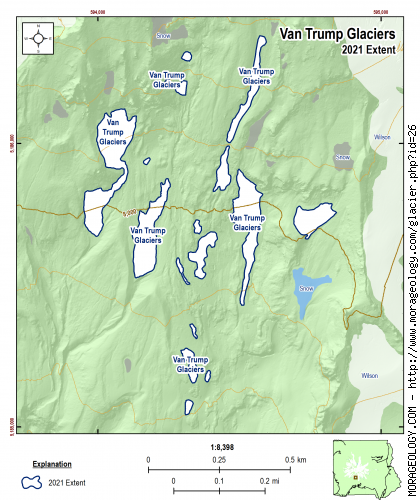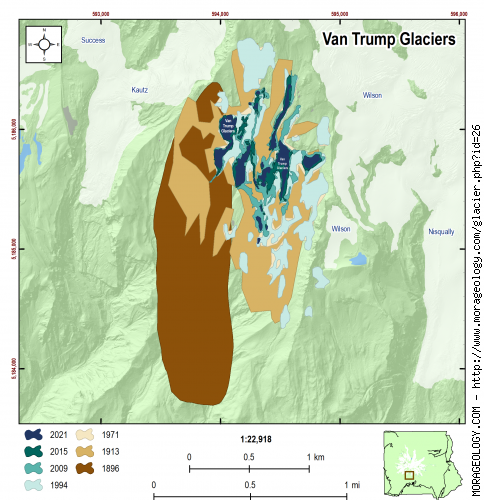NOTE: The data shown here is based on the 2021 glacier update at Mount Rainier, and should be considered the most up-to-date data on glaciers at the park (2023-04-06).
Van Trump Glaciers
Van Trump is the name of a glacier in Mount Rainier National Park. It was named for P. B. Van Trump who, with Hazard Stevens, was the first to reach the summit of the Mountain. Van Trump subsequently made several ascents of the mountain including one with John Muir in 1888. Mr. Van Trump was born in Lancaster, Ohio, on December 18,1838. He studied at both Kenyon College and the University of New York, intending to be an attorney. He never practiced law but in 1867 served as secretary to his brother-in-law Washington Territorial Governor Marshal F. Moore and was employed by the National Park Service at Rainier after the park was founded in 1899. (Reese, 2009)
Switch Glacier:

|
STATISTICS AS OF 2021 (Beason et al., 2023):
Aerial Extent:
0.045 ± 0.003 square miles
(0.117 ± 0.009 km2)
(Rank: 28 of 29)
Debris Cover - Based on data from 2015 (Beason, 2017):
--No appreciable debris cover in 2015--
Estimated Glacier Volume: (See notes below)
0.0003 ± 0.0001 cubic miles
(0.0014 ± 0.0005 km3)
Highest Elevation (Head):
8,602 feet
(2,622 m)
Lowest Elevation (Terminus):
7,540 feet
(2,298 m)
Elevation Range:
1,063 feet
(324 m)
Length:
0.30 miles
(0.48 km)
Average Slope:
27.75°
Average Flow Direction (direction the glacier flows towards):
South southeast (168°)
Glacier Type:
C - Cirque Glacier, or Glacier Head Starts Below Summit |

|
CHANGE IN EXTENT, 1896-2021 (Beason et al., 2023):
| Units |
1896 |
1913 |
1971 |
1994 |
2009 |
2015 |
2021 |
| Area, mi2 |
0.555 |
0.541 |
0.263 |
0.280 |
0.123 |
0.068 |
0.045 |
| Area, km2 |
1.438 |
1.402 |
0.681 |
0.724 |
0.318 |
0.176 |
0.117 |
Area Change Between Periods
|
1913 |
1971 |
1994 |
2009 |
2015 |
2021 |
| 1896 | -0.014 mi2
(-0.036 km2) | -0.292 mi2
(-0.757 km2) | -0.276 mi2
(-0.714 km2) | -0.433 mi2
(-1.120 km2) | -0.487 mi2
(-1.262 km2) | -0.510 mi2
(-1.321 km2) |
|---|
| 1913 | -- | -0.278 mi2
(-0.721 km2) | -0.262 mi2
(-0.678 km2) | -0.419 mi2
(-1.085 km2) | -0.473 mi2
(-1.226 km2) | -0.496 mi2
(-1.285 km2) |
|---|
| 1971 | | -- | 0.017 mi2
(0.043 km2) | -0.140 mi2
(-0.364 km2) | -0.195 mi2
(-0.505 km2) | -0.218 mi2
(-0.564 km2) |
|---|
| 1994 | | | -- | -0.157 mi2
(-0.407 km2) | -0.212 mi2
(-0.548 km2) | -0.235 mi2
(-0.607 km2) |
|---|
| 2009 | | | | -- | -0.055 mi2
(-0.142 km2) | -0.078 mi2
(-0.201 km2) |
|---|
| 2015 | | | | | -- | -0.023 mi2
(-0.059 km2) |
|---|
Percent Change Between Periods
|
1913 |
1971 |
1994 |
2009 |
2015 |
2021 |
| 1896 | -2.49% | -52.62% | -49.63% | -77.91% | -87.76% | -91.87% |
|---|
| 1913 | -- | -51.42% | -48.34% | -77.35% | -87.45% | -91.67% |
|---|
| 1971 | | -- | 6.33% | -53.38% | -74.17% | -82.85% |
|---|
| 1994 | | | -- | -56.15% | -75.71% | -83.87% |
|---|
| 2009 | | | | -- | -44.61% | -63.21% |
|---|
| 2015 | | | | | -- | -33.58% |
|---|
|
|
ESTIMATED CHANGE IN VOLUME, 1896-2021 (Beason et al., 2023):
PLEASE see important notes about this, below...
Glacier-specific Scaling Parameter, c:
0.027172
| Units |
1896 |
1913 |
1971 |
1994 |
2009 |
2015 |
2021 |
| Volume, mi3 |
0.0104 |
0.0100 |
0.0037 |
0.0041 |
0.0013 |
0.0006 |
0.0003 |
| Volume, km3 |
0.0433 |
0.0418 |
0.0156 |
0.0169 |
0.0055 |
0.0024 |
0.0014 |
Volume Change Between Periods
|
1913 |
1971 |
1994 |
2009 |
2015 |
2021 |
| 1896 | 0.000 mi3
(-0.001 km3) | -0.007 mi3
(-0.028 km3) | -0.006 mi3
(-0.026 km3) | -0.009 mi3
(-0.038 km3) | -0.010 mi3
(-0.041 km3) | -0.010 mi3
(-0.042 km3) |
|---|
| 1913 | -- | -0.006 mi3
(-0.026 km3) | -0.006 mi3
(-0.025 km3) | -0.009 mi3
(-0.036 km3) | -0.009 mi3
(-0.039 km3) | -0.010 mi3
(-0.040 km3) |
|---|
| 1971 | | -- | 0.000 mi3
(0.001 km3) | -0.002 mi3
(-0.010 km3) | -0.003 mi3
(-0.013 km3) | -0.003 mi3
(-0.014 km3) |
|---|
| 1994 | | | -- | -0.003 mi3
(-0.011 km3) | -0.003 mi3
(-0.014 km3) | -0.004 mi3
(-0.016 km3) |
|---|
| 2009 | | | | -- | -0.001 mi3
(-0.003 km3) | -0.001 mi3
(-0.004 km3) |
|---|
| 2015 | | | | | -- | 0.000 mi3
(-0.001 km3) |
|---|
Percent Change Between Periods
|
1913 |
1971 |
1994 |
2009 |
2015 |
2021 |
| 1896 | -3.39% | -64.00% | -60.85% | -87.32% | -94.35% | -96.77% |
|---|
| 1913 | -- | -62.74% | -59.48% | -86.88% | -94.15% | -96.66% |
|---|
| 1971 | | -- | 8.75% | -64.78% | -84.30% | -91.03% |
|---|
| 1994 | | | -- | -67.62% | -85.56% | -91.75% |
|---|
| 2009 | | | | -- | -55.42% | -74.52% |
|---|
| 2015 | | | | | -- | -42.85% |
|---|
Important comments about the calculation of volume shown here
The calculation of glacial volume shown on this page is based on an analysis of two methods used at Mount Rainier in the past (Driedger and Kennard [1986]; and Nylen [2001]) as well as the most recent literature review for glacier area-volume scaling (Please review Beason et al. [2023] for an in-depth discussion about this issue). It should be noted that simply converting area to volume with an equation is extremely difficult and the values presented here have extremely large error margins (likely ± 35% or more). With that in mind, the values presented here should give you an estimate of the glacial volume and change in volume over time. Please use these data very carefully with those caveats.
The calcuation of the volume is as follows:
\[V_i = {(c_iA_i^{1.375}) + (c_nA_i^{1.36}) \over 2}\]
Where:
\(V_i\) = Average volume for the glacier in question (km3);
\(c_i\) = The glacier-specific scaling parameter (back-calculated from glacier area and volume in 1971 in Driedger and Kennard (1986); Method described in Beason et al. (2023). The value for the Van Trump Glaciers is 0.027172 (this is also listed above the volume graph);
\(c_n\) = The back-calculated scaling parameter from Nylen (2001) of 0.0255; and
\(A_i\) = The measured volume of the glacier in question (km2).
This is essentially an average of the back-calculated Dreidger and Kennard (1986) and Nylen (2001) methods (D&K is in the first parenthesis; Nylen in the second). For example, for the Van Trump Glaciers in 2021, you can find the following individual volumes:
Back-calculated Dreidger and Kennard (1986) Method: 0.0003 mi3 (0.0014 km3).
Back-calculated Nylen (2001) Method: 0.0003 mi3 (0.0014 km3).
Average of the two (above equation and values listed for 2021 here): 0.0003 mi3 (0.0014 km3).
Official volume estimate listed above, with error: 0.0003 ± 0.0001 mi3 (0.0014 ± 0.0005 km3).
As you can see, the D&K method tends to produce higher values and Nylen produces lower values; the average of these two methods probably estimates the glacial volume. Until further research is done in this area and we can develop a better method or equation to determine volumes, this is the method we are using to determine glacial volumes. For more information about this method, please read the methods section of Beason et al. (2023).
|
NOTES:
-- No Notes supplied --
RAW DATA: